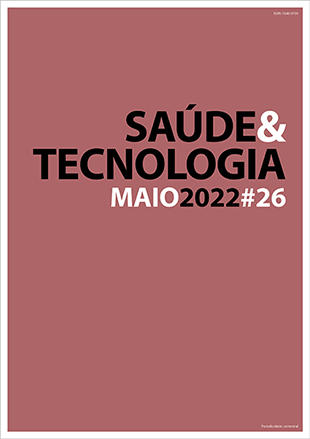Evaluation of the inhaler therapy technique in personalized health care units
DOI:
https://doi.org/10.25758/set.490Keywords:
Inhaler devices, Inhaler technique, Education, and respiratory pathologiesAbstract
Introduction – An incorrect execution of inhalation is the main reason for therapeutic failure and, therefore, it’s extremely important the proper execution of the technique so that an adequate administration of the drug in the airways occurs and, subsequently, better control of respiratory disease and a substantial improvement in the quality of life of individuals. Objectives – To evaluate the inhaler therapeutic technique performed, in a simulated form, by patients with respiratory pathologies, before and after a teaching session. Methods – The study is analytical, observational, and cross-sectional, with a sample consisting of 15 individuals from the São Tiago and São Miguel Health Centres in Castelo Branco, with any type of acquired respiratory pathology, who used inhaler devices as a therapeutic form of the disease and aged 18 years or older. Results – Most participants (80%) did not correctly perform their inhalation, making at least one major and/or minor error. Discussion – Despite the discrepancy in the number of participants between this study and some studies previously conducted by other authors, all of them showed identical results to those obtained in this study. Thus, the existing literature supports the results of this research. Conclusion – In view of the existence of patients with inhaler errors, it is essential to evaluate the frequency of their exposure to theoretical and practical information/training on the use of inhalers, with the main focus on the correction of errors detected. In this sense, technical health professionals present an indispensable role in the education and teaching of patients.
Downloads
References
Aguiar R, Lopes A, Ornelas C, Ferreira R, Caiado J, Mendes A, et al. Terapêutica inalatória: técnicas de inalação e dispositivos inalatórios [Inhaled therapy: inhalation techniques and inhalation devices]. Rev Port Imunoalergol. 2017;25(1):9-26. Portuguese
Al-Worafi YM. Evaluation of inhaler technique among patients with asthma and COPD in Yemen. J Taibah Univ Med Sci. 2018;13(5):488-90.
Clérigo A. Avaliação da eficácia do ensino das boas práticas na utilização da terapêutica inalatória em pacientes utilizadores de dispositivos pressurizados doseáveis e de pó seco [Internet]. Lisboa: Escola Superior de Tecnologia da Saúde de Lisboa/Instituto Politécnico de Lisboa; 2014. Available from: https://repositorio.ipl.pt/handle/10400.21/9200
Mesquita S, Gomes E, Cunha L, Lopes I. Dispositivos para terapêutica inalatória na criança [Children's inhalatory therapy devices]. Nascer Crescer. 2004;13(2):121-6. Portuguese
Direção-Geral da Saúde. Ensino e avaliação da técnica inalatória na asma: orientação no 010/2017, de 26/06/2017. Lisboa: DGS; 2017.
Silva PA. Caracterização da asma brônquica em idosos: avaliação da técnica inalatória em idosos asmáticos da comunidade [dissertation]. Covilhã: Universidade da Beira Interior; 2014.
Souza ML, Meneghini AC, Ferraz É, Vianna EO, Borges MC. Knowledge of and technique for using inhalation devices among asthma patients and COPD patients. J Bras Pneumol. 2009;35(9):824-31.
Aroso M, Seabra P. Avaliação da técnica de utilização dos dispositivos inalatórios pelos profissionais de uma unidade de saúde familiar [Medical personnel's knowledge of inhaler technique in healthy primary care]. AIMGF Magazine. 2018;8(2):42-7. Portuguese
Liang CY, Chen YJ, Sheu SM, Tsai CF, Chen W. Misuse of inhalers among COPD patients in a community hospital in Taiwan. Int J Chron Obstruct Pulmon Dis. 2018;13:1309-16.
Pessôa CL, Mattos MJ, Alho AR, Fischmann MM, Haerdy BM, Côrtes AC, et al. Most frequent errors in inhalation technique of patients with asthma treated at a tertiary care hospital. Einstein (Sao Paulo). 2019;17(2):eAO4397.
Giraud V, Allaert FA, Roche N. Inhaler technique and asthma: feasability and acceptability of training by pharmacists. Respir Med. 2011;105(12):1815-22.
Ahn JH, Chung JH, Shin KC, Jin HJ, Jang JG, Lee MS, et al. The effects of repeated inhaler device handling education in COPD patients: a prospective cohort study. Sci Rep. 2020;10(1):19676.
Downloads
Published
Issue
Section
License

This work is licensed under a Creative Commons Attribution-NonCommercial-NoDerivatives 4.0 International License.
The journal Saúde & Tecnologia offers immediate free access to its content, following the principle that making scientific knowledge available to the public free of charge provides greater worldwide democratization of knowledge.
The journal Saúde & Tecnologia does not charge authors any submission or article processing charges (APC).
All content is licensed under a Creative Commons CC-BY-NC-ND license. Authors have the right to: reproduce their work in physical or digital form for personal, professional, or teaching use, but not for commercial use (including the sale of the right to access the article); deposit on their website, that of their institution or in a repository an exact copy in electronic format of the article published by Saúde & Tecnologia, provided that reference is made to its publication in Saúde & Tecnologia and its content (including symbols identifying the journal) is not altered; publish in a book of which they are authors or editors the total or partial content of the manuscript, provided that reference is made to its publication in Saúde & Tecnologia.







